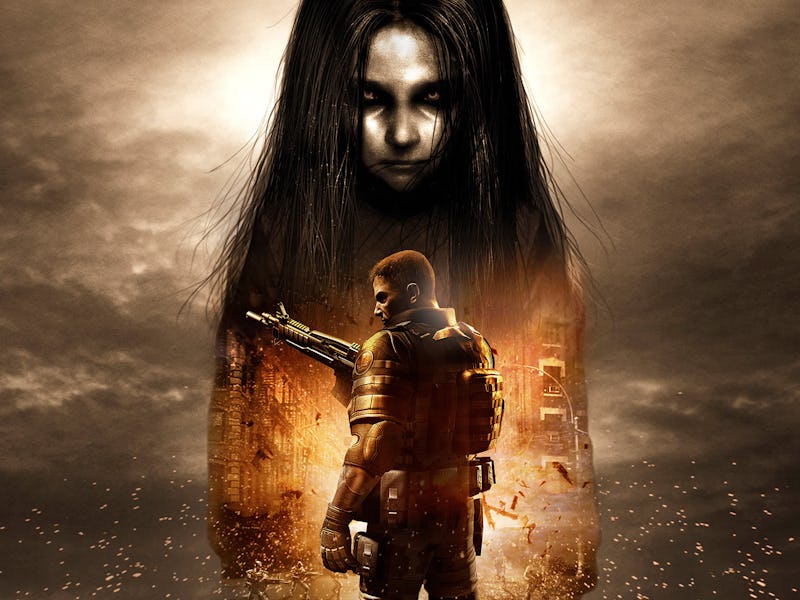Steam Has an Amazing Discount on One of the Most Underrated Horror Games Ever Made
F.E.A.R. remains a horrifyingly good shooter — even if its sequels are a mixed bag.

In 2005, Monolith Productions, the studio behind Shadow of Mordor, practically perfected the horror shooter with a tremendously underrated gem that was incredibly innovative at the time. Now, the entire trilogy is on sale on Steam for a measly $8 until December 1, and horror fans should take advantage of this incredible opportunity this Halloween.
F.E.A.R. (First Encounter Assault Recon) is a marriage between the intense shooting of Call of Duty and the paranormal horror of Silent Hill. The first game debuted on Xbox 360 and PlayStation 3 in 2005 and revolved around a secretive unit of the United States put together to respond to paranormal events.
You play as someone known only as Point Man, the leader of a F.E.A.R. squad sent in to investigate rogue agent Paxton Fettel after he disappears at a facility owned by an aerospace and medical technology company. Of course, things immediately go wrong as you’re introduced to Alma, a young girl with deadly psychic powers on a murderous rampage.
F.E.A.R. makes fantastic use of lighting and environmental design to set a mood and tone.
F.E.A.R. is a horror game for all intents and purposes, absolutely dripping with a creepy oppressive atmosphere that weighs on your every step. Monolith makes fantastic use of lighting and environmental storytelling to add an unsettling quality to every location. There’s a constant sense of dread that something horrific lies right around the corner — and more often than not it does.
Part of the brilliance of F.E.A.R. is its storytelling, which is evocative and deliberately subdued. Monolith wisely feeds the player just enough info to understand the gist of its narrative but still forces you to fill in the gaps with your imagination. This gives the story a kind of surreal quality where, at the best of times, you can only hypothesize what’s happening. This works to make F.E.A.R. seem even more eerie and unsettling, constantly keeping the player guessing.
On the flip side, F.E.A.R.’s amazing tone and sense of horror are juxtaposed against a nail-biting combat system that turns you into a human wrecking ball. The tight shooting is accentuated by acrobatic abilities like sliding, and the game employs a Max Payne-esque bullet time that turns every battle into a stunning ballet of bullets and blood.
Every firefight in F.E.A.R. feels like an experience, a cacophonic ballet of destruction.
The original F.E.A.R. was also a huge step forward for enemy AI in first-person shooters, with teams of hostiles that would flank and employ tactics against you. While progression in F.E.A.R. is linear, you still need to be aware of every environment you fight in, taking note of chokepoints, flanking areas, and how to properly maneuver your character.
The game’s intense combat, superb horror tone, and storytelling fuse into one experience that truly feels like a fever dream. One second you’re blowing away enemies like it’s The Matrix, and the next you’re fleeing from a paranormal tornado you know nothing about.
The original F.E.A.R. is an absolute masterpiece of horror, but there’s more to the franchise — although it’s a bit of a mixed bag after that first entry. F.E.A.R. 2 brings a ton of improvements to the combat and gunplay. But while it provides a lot of interesting lore, the general horror tone and atmosphere aren’t quite as top-notch as the original. Still, F.E.A.R. 2 is a fine sequel that has plenty of action and horror to deliver.
Then you have F.E.A.R. 3, which is quite a bit different from the previous two games. The series switched developers from Monolith to Day 1 Studios and got caught up in the early 2010s trend of adding a co-op mode to everything. The shooting mechanics saw a big boost with this third entry, and it still has a fantastically creepy atmosphere. But the general sense of horror falls flat. On top of this, F.E.A.R. 3 has an almost laughably bad narrative that brings absolutely nothing to the franchise at large. Its laser focus on improving the shooting and adding co-op clearly made the rest of the game suffer, but if you enjoy the first F.E.A.R., there’s plenty of reason to see things all the way through.
F.E.A.R. 2 and 3 lose some of the novelty of the first game’s horror and storytelling but still keep up the uniquely intense combat.
As a whole, the F.E.A.R. trilogy is fascinating to play through. The first game is a chilling masterpiece with real ambition that helped break new ground, but you can see the game’s success affected the franchise. F.E.A.R. is a perfect example of something visionary falling victim to the rising trends of its time.
Even still, the F.E.A.R. games managed to strike a balance between intense shooter and cerebral horror that almost no other game has managed to do. The trilogy just has a way of balancing its two elements that’s inherently compelling, even as that balance wanes in F.E.A.R. 3.
With horror games experiencing a huge resurgence in recent years through titles like Resident Evil Village and Alan Wake 2, it’s worth looking back at F.E.A.R. to see the roots of these more action-oriented horror experiences.
The F.E.A.R. trilogy is available on Steam. The set can also be played on Xbox One and Xbox Series X|S via backward compatibility, but only F.E.A.R. 2 and 3 are available for purchase on the system.
This article was originally published on